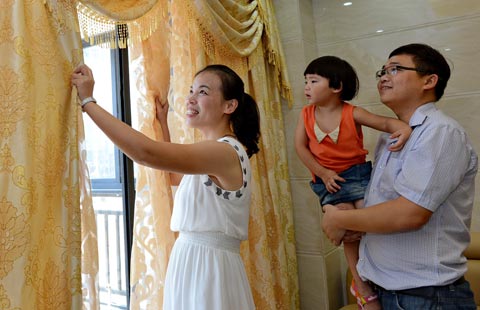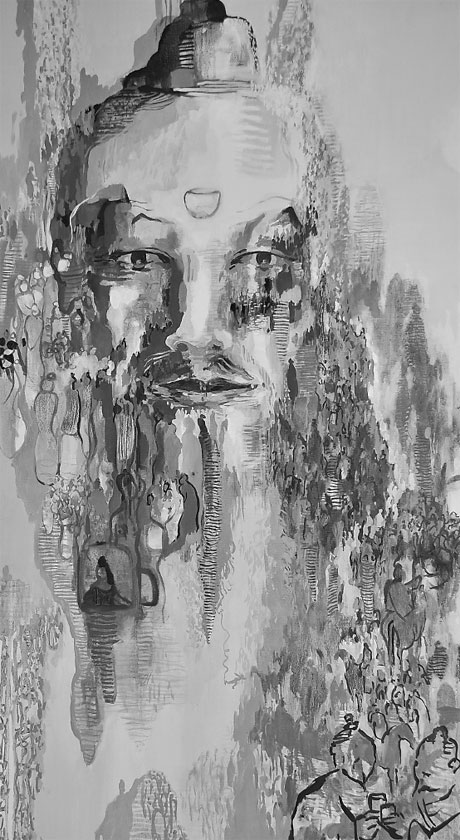Painting the poets
Updated: 2014-08-15 07:24
By Deng Zhangyu(China Daily)
|
|||||||||||
Expat Lives | Jeanyves Simon
A French artist, who has made Beijing his home, is captivated not only by the city and ordinary people in it but also by ancient Chinese poetry. Deng Zhangyu reports.
The second time French artist Jean Yves Simon met the Chinese woman who was to become his wife, in Paris in 1998, she read him a poem by Li Bai, a well-known ancient Chinese poet. Simon was instantly enchanted, and began his love affair with China, which he describes as, "a love story with a Chinese woman and Chinese poets".
|
A portrait of ancient poet Li Bai by French artist Jean Yves Simon. Photos by Jiang Dong / China Daily |
|
Jean Yves Simon in front of his painting Lost at his studio in Heiqiao, an art village in Beijing. |
At Simon's studio in Heiqiao, an art zone in Beijing, portraits of ancient Chinese poets such as Li Bai, Du Fu, Bai Juyi and Yang Wanli hang on the walls. In recent years, the oil painter has put more than 40 poets on canvas, placing the writers in landscapes they describe in their poems.
The 53-year-old usually begins his day by reading and reciting ancient Chinese poems, a habit he has continued for years. He has six ancient poetry books.
"Reading poems for me is as common as taking vitamins. These ancient poets are like my old friends. Their faces come to my mind when I paint," says Simon, adding that his favorite poets are Li Bai and Yang Wanli. The latter's poems about rain remind the artist of his hometown Brittany where it rains a lot.
Sometimes, the painter sketches imaginary faces quickly and sometimes he spends days waiting for inspiration. He never plans in advance what he will paint but he is fond of letting his brushes take him to places beyond his imagination.
The philosophy of Simon's painting style matches his fascination with ancient Chinese philosophers Laozi and Zhuangzi, pioneers of Taoism who stress naturalness and spontaneity. Taoism is also Simon's life philosophy.
Simon visited China for the first time in 2000. Before he arrived he visualized a country of mountains and lakes everywhere, just like what he saw in traditional Chinese paintings and what he read in the ancient poems.
But the urban face of Beijing surprised him. He drew a self-portrait with his eyes and mouth wide open to show his shock.
A follower of Taoism that advocates change, Simon quickly settled into life in Beijing. He has traveled across China since then, and has discovered the landscapes described in the poems he loves, in different places in China.
He has traveled to more than eight provinces and has made many sketches, illustrating China's breathtaking scenery and fascinating people.
"He always brings his sketchbooks. When he finds something interesting, he sits on the ground and writes for hours. My daughter and I are never in the same group with him," says his wife, Huang Li.
Born in a country famous for oil paintings, it's natural for Simon to focus more on ordinary people than on landscapes.
During his trip to Taishan Mountain, Simon painted cleaners, stick men and workers paving roads on the mountain. Many of them were confused, telling the painter that they were not interesting and that he should draw charming ladies instead of ordinary people like them.
"I told them they were interesting for me and they felt confused. However, they were very happy to take a photo of their portraits with their mobile phone when I finished my sketches," Simon says. He has published several sketchbooks on China.
For Simon, traveling, like painting, is part of his life. He started painting when he traveled during his childhood, which was encouraged by his father. His father took him and his sister to forests, farmlands and the Sahara desert to paint.
Simon has himself been to the Sahara desert a dozen times, to India three times and has stayed in many countries for years, including the United Kingdom and Portugal. He has lived in Beijing since 2012 and will "stay as long as necessary".
"Beijing is a changing city - I love change. Just see the number of shows held every day here. It's impossible for this to happen in France," says Simon.
The French artist quickly acquainted himself with Chinese painters and sculptors in the art village where his studio is located, and discusses China's culture and art world with them. He rides his bicycle to hutong and parks to integrate himself into Beijing life. He cycled about 4,000 kilometers last year.
In Simon's view, the crowds of people and the traffic in the city are charming and fluid like water, full of energy, as opposed to the "dullness of life in France". The city life, crowds, skyscrapers, hutong and local people stand out on his canvas, often with a red hue because he thinks red is the color of Beijing.
Huang, his wife, says that Simon had asked her to buy a red shirt and a pair of red shoes for him when he decided to stay in Beijing.
"I try to understand the culture with my eyes, ears and mouth. I love to talk to people and listen to the language even though I don't understand. I feel I'm a half Chinese now," Simon says.
Contact the writer at dengzhangyu@chinadaily.com.cn
(China Daily 08/15/2014 page20)
Today's Top News
NATO to offer tailored support to Ukraine
Babies bob about in water at US's first baby spa
News website staff face extortion probe
China's meeting on 13th five-yr plan
Number of visitors to China drops
Export of mooncakes on the rise
Putin outlines ceasefire plan for Ukraine crisis
China paves way for sports investors
Hot Topics
Lunar probe , China growth forecasts, Emission rules get tougher, China seen through 'colored lens', International board,
Editor's Picks

|

|

|

|

|

|







